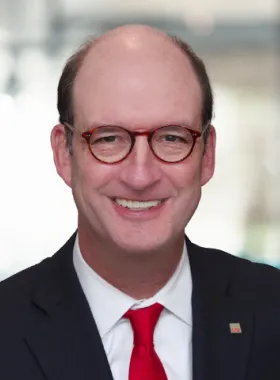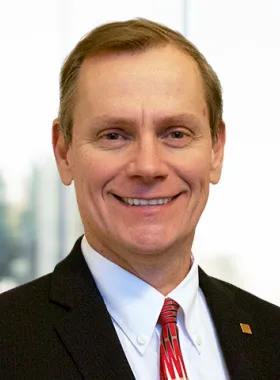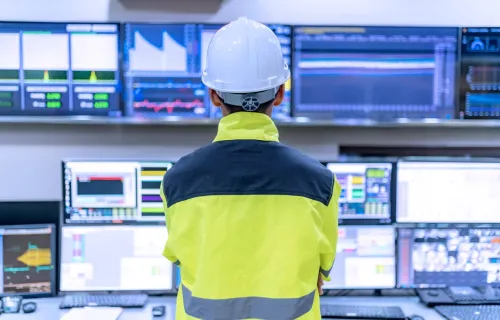Depuis des années, le secteur des services financiers soutient les clients des services publics et les consommateurs d’énergie en leur proposant des produits traditionnels tels que des prêts, des marges de crédit, des polices d’assurance et la gestion de portefeuilles d’investissements. Dernièrement, le secteur s’intéresse aux possibilités d’investissements durables dans le domaine de l’énergie et des services publics afin d’encourager ses clients à accroître la durabilité de leurs activités.
D’après Andy, cet intérêt est principalement alimenté par les exigences de la réglementation, des clients et du conseil d’administration quant aux répercussions du secteur de l’énergie et des services publics sur les changements climatiques. Il est également stimulé par l’opportunité de passer du rôle de « gardien » à celui de partenaire efficace.
Le secteur des services financiers a un rôle précis à jouer pour aider les entreprises à favoriser la durabilité et à atténuer les effets des changements climatiques. « Les dirigeants du secteur bancaire étaient réunis à Sibos l’automne dernier et ils ont clairement exprimé qu’ils comptaient adopter une ligne de conduite commune en s’associant pour devenir plus verts, plus durables et plus respectueux du climat dans leurs activités. »
Les organisations de services financiers établissent différents types de partenariats avec des clients de divers secteurs dans l’optique de favoriser le développement durable. À titre d’exemple, ils travaillent de concert dans l’exploration de nouvelles sources d’énergie et de nouveaux procédés de production d’électricité afin de se passer des combustibles fossiles. Le dialogue est favorisé par cette collaboration dans la recherche de sources d’énergie plus durables et plus vertes. « La question “Que pouvons-nous faire de plus?” stimule les échanges. Est-il possible d’atténuer ou de réduire notre empreinte carbone d’une autre manière et de créer ainsi un avenir plus durable pour tous? », exprime Andy.
À l’instar des cotes de crédit qui évaluent la santé d’une entreprise ou d’un marché, les cotes de risque et les discussions sur le développement durable feront partie des discussions courantes au sujet des portefeuilles des clients du secteur bancaire. Ces conversations mettront en lumière les domaines dans lesquels les banques sont en mesure de s’associer à leurs clients pour trouver des solutions énergétiques plus durables ou pour collaborer à la mise en place d’une infrastructure capable de soutenir une activité plus propre. « Il s’agit d’amener le client à s’affranchir d’une lourde empreinte carbone en toute transparence et harmonisée au niveau de risque qu’il est prêt à prendre dans son portefeuille », explique-t-il.
D’après lui, la gestion de la réputation du risque est beaucoup plus difficile. Il est alors essentiel qu’il y ait une certaine transparence sur la réalité courante de l’entreprise et que les prévisions sur le court, moyen et long terme soient claires. Les domaines de collaboration et d’amélioration seront mieux cernés. Le suivi et la mesure des données pertinentes seront également indispensables pour favoriser la transparence, prendre des dispositions quantifiables et démontrer les progrès réalisés par des résultats vérifiables. Toutefois, Andy rappelle que même si la qualité des données s’améliore, elle représente encore un problème auquel il faut s’attaquer.
Dans le secteur des services financiers, plusieurs tendances en matière de financement se dessinent. Les cryptomonnaies, par exemple, font l’objet d’une vive attention*. Cependant, dans l’univers bancaire, la manière de se servir de cette monnaie virtuelle est encore floue, d’après Andy. Les questions de volatilité et de vitesse doivent aussi être abordées. « Les jetons non fongibles ou JNF sont une catégorie à part en termes de création d’opportunités et de valeur », ajoute-t-il.
Pour l’instant, Andy prévoit que les banques suivront la méthode traditionnelle de financement des projets énergétiques à grande échelle. Il ajoute cependant que les entreprises plus créatives (et probablement plus petites) sont susceptibles de se tourner vers le sociofinancement et des solutions comme les JNF pour créer des options de financement plus vastes, voire décentralisées, dans le but de mobiliser des capitaux pour ce type de projets. « Vous seul imposez une limite à votre créativité, affirme-t-il.
Les banques examineront de près ces combinaisons d’investissements traditionnels et non traditionnels. Il s’agit toutefois d’une compétence sur lesquelles les banques se penchent, qu’il s’agisse d’importants clients pour obtenir des conseils fiscaux sur leurs propres actifs en cryptomonnaies, les titres détenus en JNF ou de consommateurs pour acheter ou vendre des cryptomonnaies par l’intermédiaire d’un partenaire de confiance. »
Dans l’objectif d’accélérer la transition énergétique, il est essentiel d’établir des liens solides avec l’industrie de l’énergie et des services publics. « Ce que j’aimerais voir, explique Andy, c’est davantage d’expérimentation, de projets conjoints et de coentreprises qui permettront de concrétiser cette transition. » À ses yeux, c’est un excellent début que les compagnies pétrolières envisagent d’installer des bornes de recharge pour véhicules électriques dans les stationnements des banques et des centres de traitement des données. De tels partenariats devraient être mis en place pour les toits verts, la production d’énergie verte et le financement de nouveaux types d’énergie ou de nouvelles méthodes de production.
Les banques mesurent la valeur commerciale de la durabilité environnementale. « Il est très difficile de faire des prêts si nous n’avons plus de planète sur laquelle en faire. Les banques sont motivées à apporter des améliorations, car elles reconnaissent que des occasions d’investissement existent en termes d’obligations ESG en plus d’autres types d’investissement. »
- Chapter 1: Introduction - Opportunities for greater partnership
-
Peter Warren:
Hi, everyone, and welcome to the next installment of our podcast series on energy and utilities. Today, we explore how financial services and the financial industry is influencing this marketplace. Again, I'm Peter Warren. I'm the Global Industry Lead for Energy and Utilities at CGI and my guest today is Andy (Schmidt). Andy, do you want to introduce yourself?
Andy Schmidt:
Sure. Thanks, Peter. My name's Andy Schmidt and I'm the Global Industry Lead for Banking.
Peter Warren:
Today we thought we'd cover a couple of different key points. Certainly, the world is going through a few changes. Just looking at how finance is influencing and making quite an impact on the energy marketplace — Andy, just an open-ended question, what's the historical view? And then we'll get into more of a contemporary, current view of how finance has been viewing energy and utilities.
Andy Schmidt:
Sure. So, for years, financial services, whether it's banking or insurance, has viewed energy and utilities as a market to support, but typically through traditional products like loans, lines of credit, insurance policies, even helping manage investment portfolios. It's really only recently where — and this is something that is taking place around the world — the financial services industry has taken a more, for lack of a better term, pointed or discerning look at energy and utilities and what the opportunities are.
A lot of this has to do with board sentiment, with regulatory sentiment, and of course, customer sentiment, as we look at how the climate is changing and what impacts the energy and utilities industry has on it. But also, what are the opportunities within financial services to not just be a guardian, a gatekeeper, in terms of credit, in terms of insurance policies, but also an effective partner with the industry, to outline or undertake investment in new opportunities and really create a blueprint for how other organizations might decarbonize their businesses.
- Chapter 2 - Role of financial services in the green shift
-
Peter Warren:
Picking up that last point, it's really that the green shift of energy is one of the things that's moving forward. And you mentioned the stakeholders that they have both internal, external, and their clients. Is that what they're listening to? Does a lot of it have to do with that green shift and how that's moving forward?
Andy Schmidt:
It has to do not only with the green shift but also a move away from what has been affectionately termed greenwashing. And what I mean by that is basically (not just) having good copy on the website in terms of supporting the environment. In the last few years, we've seen significant effort to move towards actionable, measurable activities, improvements, and so on, in the sustainability realm.
One of the challenges for banks specifically, and insurance companies too, is that the low-hanging fruit has already been addressed. They tried to digitize processes and move away from paper as much as possible, even support telework as much as possible. Of course, many of the buildings that banks and insurance companies use are LEED-certified, indicating that they are sustainable or at least energy-efficient.
But recently, it's been an opportunity, really even a realization in the financial services industry, that we have a specific role to play, to help drive sustainability, to help mitigate the effects of climate change by working with our clients to figure out what steps they need to take. In certain cases, as has been seen recently in the news, even severing client relationships, if they're not moving in the right direction. Now, obviously, that is a last resort, but that is an opportunity that's on the table. At Sibos last fall, we heard banking leaders being very clear that their goal is to incent, to partner, to find a common path forward, to become greener, more sustainable, more climate-friendly in terms of how business is being delivered.
- Chapter 3 – Examining sustainability in the supply chain
-
Peter Warren:
Wow. So, I mean, they're doing a lot of their own internal things, as you mentioned, they're changing their operations. I know many of the large banks, in Canada at least, have announced that they're not having everybody return to the office. That's part of their green plan, the work at home. They saw that it worked, so they're shifting. They're taking actions on their own data, with data-driven decisions. And we'll maybe expand upon that a bit more.
Then, they're looking into, as you said, the service offerings and effectively influencing the things that a client might do, let's say an energy company or a utility coming forward and saying, "We won't invest in you." You said somebody's being fired. But also, I guess they're using different pressures on those clients. How's that working when they put some pressure on somebody, "I like your project. I don't like your project."?
Andy Schmidt:
Right. Well, and there are a couple of elements that need to be considered. And one of the ways that we've seen it evidence itself more broadly is in the supply chain. So, there are certain supply chains that are efficient and some that are not. What's incumbent upon both the customer and the bank to examine is, can it be improved? Are there steps that can be taken now, or are there steps that need to be developed, either together or separately, to make it greener?
So, let's look at coal as an example. It could be that you receive your power from the local coal-based power plant. That could be a particularly dirty part of your supply chain. It may be, that is the only source of energy that's available to you right now. So, it gets put into the necessary evil category. So, you're not a bad client because you get energy from a relatively dirty source. It's an opportunity to figure out new energy sources, new ways to generate that electricity, whatever it happens to be.
The conversation you and I had about, "Can we put solar, or can we put hydrogen on rooftops, for example?" is a creative way forward to maybe not move fully away from that primary power source, but at least to supplement it and to become somewhat greener, somewhat more sustainable in terms of how you operate your business. And this creates a conversation about, "What else can we do? Are there other opportunities that we can create to mitigate, to minimize our carbon footprint and create a more sustainable future for all of us?"
- Chapter 4 – Evaluating and managing risks
-
Peter Warren:
Yeah. It's that whole ESG, financial aspect of it. One of the companies you were referring to in our other conversation was a large Canadian warehousing and distribution retailing company, and how they use wind, actually predominantly solar, on their large warehouses to make hydrogen and they converted their forklifts from propane to hydrogen. It makes a cleaner environment in the building and it moves forward in their ESG component.
So, all of that really comes down to a new definition of risk management. Energy and utilities clients view risk as assets, “Can I deliver my products and services?” But financial aspects of risk to portfolio, risk to reputation, and risk of not getting investment, I guess, are some of the things they're now having to consider. What are your thoughts on that and how that's going to play out?
Andy Schmidt:
There are a few different elements to that. So, risk portfolio: there are two key portions of that. Risk in terms of my loan portfolio, so who I am extending credit to, but even in my investment portfolio. We've actually seen much more progress on the wealth side, on the capital market side, in terms of creating these ESG portfolios and moving towards them, wherever possible.
The risk reputation piece of it is much harder to manage because you're very much in the court of public opinion. Now, what's one of the best ways to mitigate or to address that? It's transparency and being able to acknowledge that there are certain things that we need to fix and can't fix right now, because the technology doesn't exist or the capacity isn't there yet, but we're working on it. As well as, these are the things that we're doing in the short, medium, and long-term. So, you're being very clear on what you can affect and what you can't.
- Chapter 5 – Opportunities to solve sustainability challenges together
-
So, back to the issue about coal-based electricity, just because that's an easy target for many. It creates an opportunity to also say, "Let's partner, let's figure out a way to do this. I have a specific business problem. I, the corporate bank, am willing to invest in it. I, the bank, am willing to possibly fund it or partner to help deliver it more broadly. Let's solve this problem together." But transparency, data, and being able to show what you're working on, being able to have auditable results — and data quality is an issue, it's improving, but it is an issue — are key ways forward.
Now, that last element that you mentioned, the risk of not getting investment. In that recent case, where that bank did sever relationships with a couple dozen coal companies, that is a last resort, but that risk of not getting investment is absolutely there. Why did they sever the relationship? They didn't see the progress that they gave the clients a year to undertake or a year to show. And so, we don't know, were there subsequent discussions about partnership and so on?
But just as banks and insurance companies have credit scores in terms of the health of the business, the health of the market, the quality of the leadership, etc., so, too, you will see risk scores, or at least a risk discussion, on the sustainability piece of it. Are they moving in a sustainable way? Is there a risk in the marketplace in terms of perception, in terms of market, in terms of regulation, if these firms don't improve?
So, it will become part of the regular portfolio conversation with the client, in terms of how they're getting their energy, what other business processes can they improve, can you clean up the supply chain? So, back to the supply chain issue. Can we help you find a more sustainable alternative without radically changing your business? Or is it an opportunity, for example, for us to work with you, to build a new plant, to make that portion of your business that much cleaner?
Now, it does take some creativity and it does take some guts to go in that direction, but this is where the market's heading. And we're seeing more support than ever before at the board level, to make these types of changes, because the effects of climate change are readily evident right now.
Peter Warren:
Yeah, it's a key component. We see this in the whole struggle with ESG financing. We have one utility client who wants to be able to prove that their electrons are cleaner than someone else's, to your earlier point. So, in a competitive market, I can prove to you because I am putting in good finances and good tools, I can prove that my electron is greener, and is going to be something that everybody's going to want to be able to do in the future as they move into it. Hence, that’s the reason they're getting some investment in that and moving along a little bit differently than perhaps some of their competitors.
- Chapter 6 – Funding methods in the new economy
-
Peter Warren:
How do you see funding being done in the new economy? We've got crypto, we've got a lot of other things coming in here. What are your thoughts on that? I know you recently published something in one of the magazines, you can comment on that as well, too, but you've looked into a couple of different points here.
Andy Schmidt:
Right. So, the conversation that we had with Forbes was around, what's the practicality of crypto? Crypto's capturing a tremendous amount of attention right now, for sure. So far in the banking world, there's not a tremendous amount of clarity on how you would use it. It's certainly being viewed as an investment for some, as a payment type for others. Volatility and speed are key issues that need to be addressed. Non-fungible tokens or NFTs, are their own animal in terms of creating opportunity, creating value.
So, for the time being, and let's step back and be clear, banking and insurance are two traditionally risk-averse industries. They are rarely at the cutting edge. I do think, at least for the time being, that traditional funding methods will be used to move some of these large-scale projects forward. If you're talking about building a new plant, for example, traditional funding will likely apply.
That said, more creative corporates, probably smaller corporates, may turn to crowdfunding, may turn to sources like NFTs to create a more widespread perhaps even decentralized financing option to raise capital for these types of projects. Really, the boundaries are only limited by your creativity.
- Chapter 7 – Impact of crypto and virtual currency
-
Andy Schmidt:
Now, if I were the lender and I saw this mix of nontraditional lending or nontraditional capital like virtual currency or crypto, and so on, plus traditional capital like bank loans, bonds, etc., I would have to, not just as the lender but as the risk organization, take a closer look to see what that volatility is, what the risk is.
But, this is a muscle that banks are increasingly developing, whether it's their wealth customers looking for tax advice in terms of their own crypto holdings or their own NFT holdings, or also, the advent of central bank digital currency (CBDC) and how that might affect things. But also, the news recently and episodically around firms like overstock.com, or Dell, or Tesla, accepting Bitcoin, and the impact that these firms can have on the virtual currency market.
Elon Musk famously tanked Bitcoin's value by saying that it wasn't environmentally responsible and so they weren't going to accept it anymore. But, here we have in the article that we were talking about just this week, Exxon Mobil is using excess natural gas to power crypto mining. So, you're using something that would be vented into the atmosphere anyway, as just a byproduct of the oil and gas recovery, mining, drilling process, to create cryptocurrency. Again, the limits are only a function of your creativity.
So, the market put up, created, or identified a problem: Bitcoin is not sustainable, not friendly to the environment. The industry came up with a solution. Let's use things that are waste products anyway, and try and figure out a way to convert that into value. Now, will that achieve great scale? Hard to say. But again, it's a creative market that's looking for creative solutions and the banks will appreciate that. They'll say, "Let's solve the problem together." Would they fund an ability to capture natural gas for Bitcoin mining purposes? Unclear. But they certainly would view that as a way to help mitigate impacts and to create new opportunities.
It is an interesting, almost Wild West part of the market, but that's where opportunity is created. So, I think these types of conversations will continue and that credit, the capital, will become increasingly decentralized. But it's really all about the conversation with the client to figure out how the banks, the insurance companies, can help them move away from a heavy carbon footprint. And do it in a way that is transparent and that fits with the criteria for the level of risk that they're willing to take in their portfolios.
- Chapter 8 – Looking at waste products differently
-
Peter Warren:
While you were talking, I was thinking about one of these podcasts we're going to do too, as well, with our counterpart, Helena (Jochberger), that leads up to manufacturing in the circular economy. We're talking at an event she's putting on later in May with folks on her components and the circular economy, reusing what was considered a waste product from the mining industry, which is ammonia, which actually contains more hydrogen, as most people know, than hydrogen itself when you look at the density of it. It’s easier to move around. It is caustic. It is a nasty thing in its own right, but it is being considered for vehicles and other transport, shipping and so on.
So, we're starting to look at these waste products or excess product and look forward differently. I think, to your earlier point, you have to really watch that you don't greenwash these things. I mean, you have to really be able to prove, to your point about data, that this is something that is better than what it was before, and it’s truly waste or it's not just something I could have stored. I'm actually doing something that's proper for the economy.
- Chapter 9 – Potential future areas for cooperation
-
Peter Warren:
Asking a wrap-up couple of questions here: how do you see this moving forward, along with the connection between banking clients, energy and utility clients, the way that the two are really influencing each other, where do you see this maybe 5, 10 years out?
Andy Schmidt:
It's a great question. What I'd like to see is a bit more experimentation, joint projects, joint ventures, to figure out how can we make these things work. So, again, back to low-hanging fruit for a moment. The discussions about oil companies wanting to put EV charging stations in the parking lots of banks and data centers. Great for a start.
What I'd like to see is an expansion of that partnership towards green rooftops, towards green energy generation, and in terms of actually being able to fund new energy types or new energy production methods. Even as you mentioned around ammonia, be able to work together to figure out new waste energy sources.
One of the topics that comes to mind is the fashion industry and the food industry, the amount of waste that's created there. This takes me back to the '80s with Back to the Future and Marty McFly and Mr. Fusion. But we're moving towards that type of mindset. It's just waste, so let's turn it into energy. We've been doing that with incinerators for some time. So, it's really no different. It's just making it, either A, more portable, or B, more inclusive in terms of the waste that you're leveraging.
Whether it's joint ventures, whether it's incubators, whether it's joint competition, STEM efforts, etc., this is where I would like to see the cooperation going and have both industries take a stake in this. The banks realize full well that it's really hard to lend credit if there's no planet to lend credit on. At the same time, they recognize that there are investment opportunities in terms of ESG bonds and other investment types. They are incented to make improvements.
So, too, I would believe, the energy and utilities firms are incented to make sure that their market survives and to be able to leverage and really make more accessible, alternative energy types. Or even more widespread accessibility towards what is becoming, at least in my opinion, more mainstream energy types like wind and solar. So, personally, I'm seeing a lot more solar installations on rooftops in my neighborhood, complete with advertising from the local provider on how to get involved. In my state, looking toward increasing funding, and the utilities that are actually doing this, toward saving traditional energy or traditional coal and natural gas-created energy, by leveraging solar. So, it is a joint effort. I would hope to see that this partnership would continue and if not expand, to have some breakthroughs in terms of what we can do and of course, how we can deliver it.
- Chapter 10 – Wrap-up
-
Peter Warren:
That's great. Well, thank you very much, Andy. This has been a good conversation. This came from you and I talking about these things in our personal business lives as well. So, I'll give you a chance here to do a shameless plug for perhaps some future banking podcasts, as well.
Andy Schmidt:
Absolutely. Yes. We're definitely looking to ride on the coattails of your success in terms of creating these podcasts and creating awareness and interest around it. So, we are in the process of outlining what topics we want to focus on. They're going to be a mix of some of the hot topics, but also some of the further-reaching, long-range topics that banks need to consider. I look forward to creating and publishing those in the near term.
Peter Warren:
That's great. Well, a shout-out to our audience, if you have ideas and suggestions, we're all ears. Please feel free to comment back on the channel that you've picked this up and we'll follow up with you again. So, we'll wrap up here. Thank you very much, Andy.
Andy Schmidt:
Thank you, Peter.
Peter Warren:
And we'll talk to everybody later. Bye-bye.






